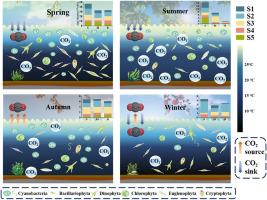藻类群落可以在不同季节改变饮用水水库作为二氧化碳源或汇的作用。
IF 7.7
2区 环境科学与生态学
Q1 ENVIRONMENTAL SCIENCES
引用次数: 0
摘要
在大型饮用水库中,CO2通量(F(CO2))的变化受到物理过程、生物群落结构和功能策略的限制。本研究探讨了浮游植物群落组成和多样性结构与CO2浓度(C(CO2))和通量的垂直响应关系。该指标包括丹江口水库不同水层在2023年11月至2024年8月的不同季节。夏季浮游植物α-多样性指数最高,冬季最低。F(CO2)表现出季节性的变化规律。秋季CO2源最强,为260.14±56.81 mg·(m2·d)-1,春季CO2汇最强,为-261±113.38 mg·(m2·d)-1。同时,春夏季底水柱C(CO2)较高,最高可达1,939.83±159.31 ppm。线性回归和冗余分析(RDA)表明,水温(WT)、溶解氧(DO)和高锰酸钾化学需氧量指数(CODMn)反映了CO2积累和浮游植物群落结构的变化。偏最小二乘路径模型(PLS-PM)进一步揭示了气象因子(p < 0.001)、水化学因子(p < 0.05)和浮游植物多样性(p < 0.05)对C(CO2)的显著影响。不同水深藻类群落的变化决定了水库是CO2源还是CO2汇。微囊藻(Microcystis sp.)和假丝藻(Eudorina sp.)在表层更有利于CO2汇,而在中层和底层更有利于CO2源,而Asterionella sp.则在不同水层对CO2有吸收作用。该研究对大型饮用水库CO2源汇状态的动态变化具有重要的生态意义。本文章由计算机程序翻译,如有差异,请以英文原文为准。

Algal community can alter the role of a drinking water Reservoir as a CO2 source or sink at different seasons
In large drinking water reservoirs, changes in CO2 flux (F(CO2)) are limited by physical processes, biological community structure and functional strategies. This study investigates the vertical response relationship between the composition and diversity structure of the phytoplankton community, CO2 concentration (C(CO2)) and flux. The indicators included different water layers in the Danjiangkou Reservoir (DJR) across seasons from November 2023 to August 2024. The α-diversity index of phytoplankton was highest in summer and lowest in winter. The F(CO2) showed a seasonal rhythm. The strongest CO2 source occurred in autumn with 260.14 ± 56.81 mg·(m2·d)−1 and the strongest CO2 sink occurred in spring with −261 ± 113.38 mg·(m2·d)−1. Concurrently, the bottom water column exhibited relatively high C(CO2) in spring and summer, reaching up to 1939.83 ± 159.31 ppm. Linear regression and redundancy analysis (RDA) showed that water temperature (WT), dissolved oxygen (DO), and the potassium permanganate chemical oxygen demand index (CODMn) reflected the change of CO2 accumulation and phytoplankton community structure. Partial Least Squares Path Modeling (PLS-PM) further revealed that meteorological factors (p < 0.001), hydrochemical factors (p < 0.05), and phytoplankton diversity (p < 0.05) significantly affected C(CO2). The change of algae community at different water depths determines whether the reservoir is a CO2 source or a sink. For example, Microcystis sp. and Eudorina sp. were more conducive to CO2 sinks in the surface layer, but more conducive to CO2 sources in the middle and bottom layers, while Asterionella sp. contributed to CO2 sequestration in different water layers. This study has critical ecological significance for the dynamic transformation of CO2 source and sink states in large drinking water reservoirs.
求助全文
通过发布文献求助,成功后即可免费获取论文全文。
去求助
来源期刊

Environmental Research
环境科学-公共卫生、环境卫生与职业卫生
CiteScore
12.60
自引率
8.40%
发文量
2480
审稿时长
4.7 months
期刊介绍:
The Environmental Research journal presents a broad range of interdisciplinary research, focused on addressing worldwide environmental concerns and featuring innovative findings. Our publication strives to explore relevant anthropogenic issues across various environmental sectors, showcasing practical applications in real-life settings.
 求助内容:
求助内容: 应助结果提醒方式:
应助结果提醒方式:


